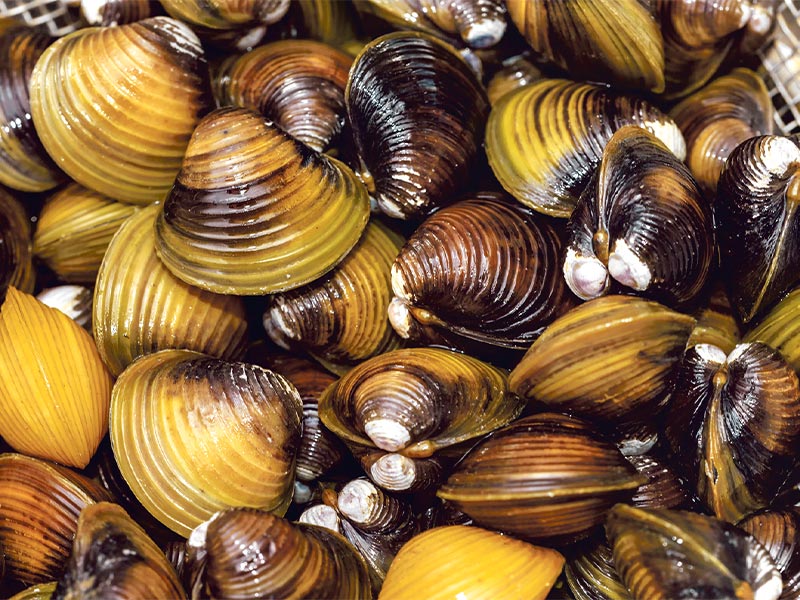Lake Ōkataina closed
4 min read
Freshwater gold clams are prolific breeders and can produce 400 juveniles a day and up to 70,000 juveniles a year. Photo: Adobe Stock
Lake Ōkataina, a significant and popular trout fishing spot, will be closed for boating and fishing for a month, from 1 to 31 October, as part of a precautionary approach to reduce the risk of spread from the freshwater gold clam.
The announcement came days before the trout season opened on 1 October. Fish & Game New Zealand called this “a blow for anglers on the eve of the new fishing season” in a statement released.
The temporary closure (controlled area notice – CAN) is in response to a request from Ngāti Tarāwhai to protect the lake.
“Lake Ōkataina holds special cultural significance to Ngāti Tarāwhai because it contains a drowned pa site and other submerged Māori archaeological features. It is also a popular trout fishing lake and its popularity with fishers, many who travel from Waikato, makes it vulnerable. It is also a lake of high ecological value, and these features are recognised by certain restrictions already placed on some lake uses,” said Biosecurity New Zealand deputy director-general Stuart Anderson.
Gold clams, also known as Asian clam, was discovered in the Bob’s Landing area in the Waikato river near Lake Karāpiro in early May 2023. Following an initial surveillance, Biosecurity New Zealand specialists found significant numbers of the clam up to 1.5km upstream from Bob’s Landing and as far downstream as Hamilton city.
Freshwater gold clams are prolific breeders and can produce 400 juveniles a day and up to 70,000 juveniles a year.
“Biosecurity New Zealand is taking a cautious and balanced approach to managing this clam that allows people to enjoy our lakes and rivers while protecting them from this invasive shellfish,” said Anderson.
During the closure period, boat cleaning facilities will be installed. Cleaning stations will also be installed in the Waikato to help river and lake users meet Check Clean Dry requirements.
“We appreciate people want to get on Lake Ōkataina at the start of the trout fishing season, but a small sacrifice this month goes a long way towards preserving it for generations to come,” said Anderson.
“Once we have the facilities to ensure all boats coming into the lake are clam-free, the lake will be open to enjoy for the remainder of the season.”
Fish & Game New Zealand chair Barrie Barnes said while he understood concerns raised by Te Arawa Lakes Trust and Ngāti Tarāwhai, the closure was “concerning”.
“…the Waikato River system and Lake Karapiro, where the clams were first confirmed, remain subject to minimal restrictions imposed by MPI. Since then, the clams have also spread to Lake Maraetai.
“We believe MPI and the Waikato Regional Council should have adopted more stringent measures at ground zero to prevent the spread of gold clams to other regions. Planning to carry out more surveillance measures in Rotorua waterways and planning trials to determine the feasibility of suppressing the clam population in the Waikato in November is closing the barn door after the horse has bolted.”
Fish & Game has been at the forefront of promoting effective biosecurity practices at rivers and lakes nationwide, Barnes said.
He said the Rotorua lakes attract between 120,000 and 150,000 angler days per season, with Lake Ōkataina recognised as one of the premier “trophy” rainbow trout lakes within the Rotorua lakes fishery. Fish & Game’s National Angler Survey revealed that approximately 6000 to 7000 angler days are recorded at Lake Ōkataina each season.
With the fishing season now open (from 1 October), Barnes said Fish & Game encourages anglers “to continue adhering to sound biosecurity practices, which include inspecting, cleaning, and drying all equipment and promptly reporting any sightings of the clams to MPI.”
The CAN prohibits the movement of boats and other watercraft and fishing equipment, including rods, waders, and nets, into the lake. Anyone who needs to continue using boats in the lake during the period can apply for a special permit.
“We continue to work with all parties to protect our freshwater environment from this clam,” said Anderson.
“We have completed extensive surveillance of the Waikato River and its wider catchment we have also undertaken surveillance at six national sites so far, with no positive results. We are planning, with regional councils, to carry out surveillance at approximately 80 further sites. Surveillance of a number of waterways around Rotorua undertaken by Te Arawa Lakes Trust and Bay of Plenty Regional Council has also found no evidence of the clam.
“We are also planning to run trials to determine the feasibility of suppressing the clam population in the Waikato River and these should be underway by November.”



